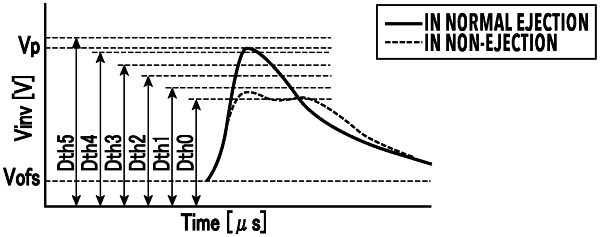| CPC B41J 2/04563 (2013.01) [B41J 2/0458 (2013.01)] | 15 Claims |

|
1. A recording apparatus comprising:
a liquid ejection head including (1) a heating element that generates thermal energy required to eject liquid, the liquid including pigment charged to a negative potential, (2) a first protection layer that blocks contact between the heating element and the liquid, (3) a second protection layer that covers at least a portion of the first protection layer to be heated by the heating element and that functions as a first electrode, (4) a second electrode that is electrically connected to the first electrode through the liquid, (5) an ejection port that ejects the liquid, and (6) a temperature detection element that corresponds to the heating element;
a detection unit configured to detect a feature point in a temperature curve that is obtained by the temperature detection element and that indicates a relationship between time and temperature; and
a determination unit configured to determine whether or not the liquid is normally ejected from the ejection port based on whether or not the detection unit has detected the feature point in the temperature curve,
wherein the recording apparatus has (1) a non-ejection determination mode using the determination unit and (2) a printing mode in which printing is performed without using the determination unit,
wherein in the printing mode, a potential set for the first electrode and a potential set for the second electrode are controlled so that an electric field that reduces a presence ratio of the pigment near a surface of the second protection layer is formed between the first electrode and the second electrode, and
wherein in the non-ejection determination mode, the potential set for the first electrode and the potential set for the second electrode are made different from that under potential control in the printing mode.
|